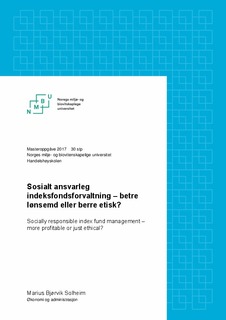| dc.contributor.advisor | Romstad, Eirik | |
| dc.contributor.author | Solheim, Marius Bjørvik | |
| dc.coverage.spatial | Norway | nb_NO |
| dc.date.accessioned | 2017-08-29T09:21:45Z | |
| dc.date.available | 2017-08-29T09:21:45Z | |
| dc.date.issued | 2017 | |
| dc.identifier.uri | http://hdl.handle.net/11250/2452185 | |
| dc.description.abstract | Føremålet med denne oppgåva er å vurdere om investorar i samfunnsansvarlege norske indeksfond med antatt redusert investeringsunivers får lågare risikojustert avkasting enn tilsvarande konvensjonelle indeksfond.
For å vurdere denne problemstillinga er sju konvensjonelle indeksfond samanlikna med seks norske indeksfond med etiske omsyn i høve føretaksutveljing. Samanlikninga tek utgangspunkt i dei globale og framveksande marknadane, og er basert på observerte historiske data i perioden mars 2012 til mars 2017.
I tillegg til tradisjonelle metodar for å kopiere referanseindeks, nyttar samfunnsansvarlege norske indeksfondsforvaltarar normbasert seleksjon der ein utelet føretak som ikkje oppfyller retningslinjer frå FN eller OECD. Dessutan nyttar forvaltarane negativ seleksjon der ein utelet visse føretak mellom anna i omstridde bransjar som våpen og tobakksbransjen.
Samanlikninga er utført ved å vurdere utviklinga til fonda, og porteføljar av desse fonda, i analyseperioden med omsyn på risiko, avkasting og risikojustert avkasting. Det vert kalkulert ytingsmål og gjennomført signifikanttestar i form av t-test, Mann-Whitney test, F-test og Levene test.
Resultat frå studia syner at samfunnsansvarlege indeksfond har svakt lågare årleg avkasting globalt (-0,18%) og i framveksande marknadar (-0,37%) enn tilsvarande konvensjonelle fond. Risiko, målt ved standardavvik, er svakt høgare i samfunnsansvarlege indeksfond med 0,39% årleg i globale marknadar og 0,19% i framveksande markandar. Med det vert også risikojustert avkasting svakt lågare for samfunnsansvarlege fond med negativ informasjonsrate målt mot konvensjonelle fond som referanse på høvesvis (-0,19) globalt og (-0,41) i framveksande marknadar. Skilnadane er likevel ikkje signifikante ved 5% eller 10% nivå. | nb_NO |
| dc.description.abstract | The purpose of this thesis is to assess whether investors in socially responsible Norwegian index funds with assumed reduced investment universe receive lower risk-adjusted returns than the corresponding conventional index funds.
To evaluate this research question, seven conventional index funds are compared to six Norwegian index funds with ethical considerations in terms of company selection. The comparison is based at the global and emerging markets on observed historical data in the period March 2012 to March 2017.
In addition to traditional methods for benchmark tracking, the Norwegian socially responsible index fund managers are using norm-based screening where companies not in line with guidelines from United Nations or OECD are excluded. Moreover, the fund managers also use negative exclusions screening where they exclude certain companies, for example in controversial sectors such as weapon and the tobacco industry.
Comparisons have been carried out by evaluating the development in the selected funds, and portfolios of these funds, during the investigated period. With considerations of risk, return and risk-adjusted returns. I calculate performance measures and test for significance using the T-test, the F-test, the Mann-Whitney test and the Levene test.
Results from the study show that the socially responsible index funds have slightly lower annual returns with (-0,18%) global and (-0,37%) in emerging markets compared to the conventional index funds. Risk, measured by standard deviation, is slightly higher in socially responsible index funds with 0,39% globally and 0,19% in emerging markets on a yearly basis. Thus, risk-adjusted returns are also slightly lower for socially responsible index funds. Measured as information ratio with conventional funds as the benchmark, the socially responsible index portfolio has a negative information ratio at (-0,19) globally and (-0,41) in emerging markets. However, the differences are not significant at neither the 5% nor the 10% level. | nb_NO |
| dc.language.iso | nno | nb_NO |
| dc.publisher | Norwegian University of Life Sciences, Ås | nb_NO |
| dc.rights | Attribution-NonCommercial-NoDerivatives 4.0 Internasjonal | * |
| dc.rights.uri | http://creativecommons.org/licenses/by-nc-nd/4.0/deed.no | * |
| dc.subject | Indeksfondsforvaltning | nb_NO |
| dc.subject | Etisk kapitalforvaltning | nb_NO |
| dc.subject | Samfunnsansvar | nb_NO |
| dc.title | Sosialt ansvarleg indeksfondsforvaltning : betre lønsemd eller berre etisk? | nb_NO |
| dc.title.alternative | Socially responsible index fund management : more profitable or just ethical? | nb_NO |
| dc.type | Master thesis | nb_NO |
| dc.subject.nsi | VDP::Samfunnsvitenskap: 200::Økonomi: 210 | nb_NO |
| dc.source.pagenumber | 61 | nb_NO |
| dc.description.localcode | M-ØA | nb_NO |

